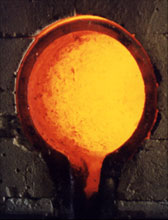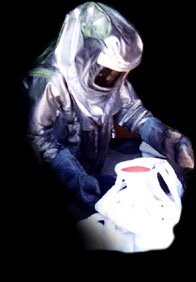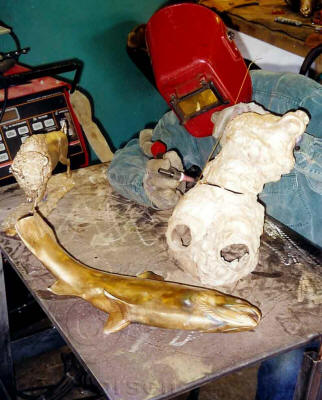
Creating Bronze sculptures
today
uses similar processes as antiquity.
Bronze sculptures,
traditionally offered as limited edition castings by artists, are each
considered original works of art due to the arduous process required for
production.

STEP 1
The artist creates a sculpture in clay or wax.
STEP 2
The original sculpture is molded. Larger sculptures, or complex
sculptures are cut into parts and molded separately. Each part will be
cast separately and reassembled later in bronze.
MOLD
The mold is made from a flexible silicon material. The mold is the
negative of the sculpture. The soft, flexible material captures all the
detail of the original sculpture created by the artist.
This mold is reused again and again until the entire edition has been
cast. At that time the mold
is destroyed, thus insuring that once sold out, the edition will never
again be produced.
STEP 3
The original sculpture is remove from the mold and Wax is poured into
the mold. When the wax cools, this replica of the artist's original
sculpture is removed from the mold. Any blemishes on the wax surface are
meticulously removed. Now the wax sculpture resembles the original work
of art, and it is then ready for investment.
STEP 4
Investment. This process is time consuming, requiring the wax replica to
be dipped into a binder (like glue) and rolled in sand. Repeating this
process several times builds a sand shell around the wax replica.
STEP 5
After the layering process is finished, the wax and shell are placed
into a kiln. The wax warms to a gas state and burns out of the shell,
simultaneously the sand shell hardens. The impression from the wax
sculpture is left on the interior of the sand shell.
STEP 6
Molten bronze is then poured into the sand shell. This plaster like mold
can withstand the intense temperature of the liquid metal. Once the
bronze cools, the sand shell is chipped away from the bronze. The metal
sculpture is examined to insure quality.
STEP 7
The parts of the sculpture are reassembled with the aid of welding
torches, and air driven grinding tools. Once the sculpture is
reassembled, the original texture is matched. A final inspection of the
metal sculpture is made before coloration.
STEP 8
Patina is the traditional technique for coloring bronzes. This is an
oxidation process. Chemicals are applied to the metal surface using
heat. The bronze reacts to each chemical differently, creating a change
in color to the metal surface. The variety of colors that can be
achieved is vast. An almost limitless variety of colors can be achieved
by this process
STEP 9
When the sculpture is completed, the artist may choose to present the
sculpture on a wooden or stone base. Larger sculptures are traditionally
placed in parks, gardens and entry ways to buildings or homes.
More Questions about the process? Call the Gallery and Ask!
